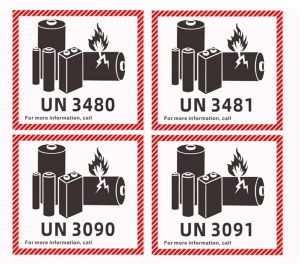
Shipping Batteries Internationally
Many electrical devices – from laptops to medical devices and power tools – contain batteries. And when they’re shipped across borders, there are strict regulations that must be followed.
These requirements will vary depending on the type of battery and whether they are pre-installed within the device they’re powering.
Lithium Batteries
Lithium batteries are an essential power source for many consumer electronics products such as laptops, smartphones and e-bikes. Unfortunately, these batteries also present a fire risk to human beings and property. When lithium batteries overheat they can explode or catch fire, releasing toxic gases and burning away anything nearby.
This is why shipping lithium batteries and equipment/products with batteries installed must be done very carefully. Whether you need to ship these devices by air or sea freight, there are certain hazmat regulatory requirements that must be met.
In general, a battery must be packed in a protective container with an internal layer of non-flammable foam to prevent damage and short circuits. A battery must also have a label that clearly states it as a dangerous good. Additionally, the package must be marked with a UN number and a Dangerous Goods Declaration (DGD).
Some courier services may request additional documentation before shipping lithium batteries or equipment/products with batteries. This can include a Material Safety Data Sheet or a UN38.3 Certificate, and is considered on a case-by-case basis. Additionally, you may need to sign a Dangerous Goods Contract, which is also determined on a case-by-case basis.
Alkaline Batteries
Although lithium batteries are more commonly associated with international shipping by courier, there is also a large market for alkaline batteries. These are the AA, AAA, C and D-sized batteries found in countless devices we use on a daily basis. They are a popular choice for household devices such as flashlights and digital cameras and offer the benefit of being less expensive than rechargeable lithium-ion batteries.
The global alkaline battery market generated about $6 billion in revenue in 2010. The popularity of these primary batteries in developed countries in the United States and Europe contributes to their steady demand. Their lower price and long shelf life make them a more viable option to replace the older 1.5-volt zinc-carbon batteries that have powered consumer electronics for decades.
However, this market faces challenges including rising costs for raw materials such as zinc and electrolytic manganese dioxide (EMD). The cost increase has put pressure on the alkaline battery manufacturers to reduce shipping batteries internationally production expenses in order to maintain their profit margin.
In general, AA-sized alkaline batteries are classified as dry cell batteries and are not considered hazardous for air transport by the US Department of Transportation, International Civil Aviation Organization or IATA. The batteries should be well insulated during shipping in order to avoid short-circuiting. Alkaline batteries should not be thrown in with domestic waste, and instead should be recycled or disposed of properly as instructed by local and state regulations.
Rechargeable Batteries
Shipping rechargeable batteries internationally can be a bit more complicated than you might think. These batteries are considered to be ‘Dangerous Goods’ because they contain lithium, which can, under certain conditions, catch fire. This is why there are some strict guidelines that you need to follow when it comes to preparing and packing them for transport.
Lithium-ion rechargeable batteries are used in the majority of consumer electronic devices, such as portable phones, laptops, tablets and power banks. They’re also common in remote control toys and many other electrical devices. Typically, you won’t be able to check in these kinds of batteries as luggage on flights, because they’re not permitted under airline regulations.
When it comes to sending these rechargeable batteries, you’ll need to make sure that they’re shipped in their original packaging and are well protected from any bumps or knocks during transit. For this, you might want to wrap them in bubble wrap or put them inside a sturdy box. You’ll also need to label your package as containing dangerous goods, in line with ICAO and IATA guidelines.
Non-compliance can result in a number of consequences. At the worst, your shipment might be seized or rejected by your chosen courier. At the very least, it could lead to a delay in getting your batteries where they need to be, and possibly even a costly fine.
Lithium Metal Batteries
When relocating overseas, it’s likely that you will need to ship your batteries or devices which contain them. This can raise some concerns because there is a lot of misinformation and incorrect guidance on forums regarding whether you can safely send lithium batteries and devices overseas. In fact, you can, but there are strict guidelines which must be followed when shipping them, particularly by air freight.
Lithium metal batteries are those which are found in your everyday non-rechargeable AA or AAA batteries and some smaller electric devices, such as shipping batteries internationally laptops, cameras, and gardening tools. These are the ones that require the most careful handling and shipping as they pose a risk of fire. Due to this, these batteries are the main type that require a Dangerous Goods label when shipped.
The DOT and PHMSA have strict standards in place which must be met when preparing and shipping batteries or battery cells to ensure they are safe for transport. In addition, the person, company or entity who is identified as the Shipper on the shipment waybill is responsible for ensuring 100% compliance with the IATA Dangerous Goods Regulations when shipping batteries internationally.
There have been many plane crashes and boat sinkings caused by non-compliance with these rules, which is why it’s so important to always follow the guidelines when shipping batteries abroad. Getting it wrong could cause major problems for your shipment and for those who are handling it on the other end.



